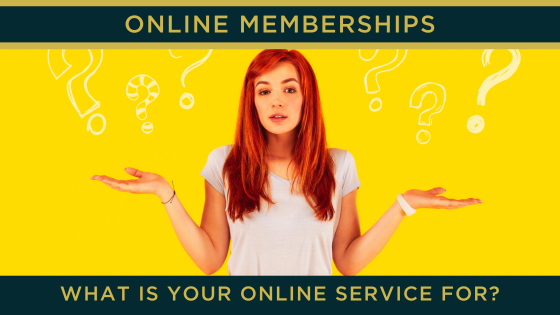It really helps to know what your online membership is FOR!
Okay. I know that title sounds like a ridiculously obvious statement, but you’d be surprised how many people have never considered their online membership at a strategic level and thought about purpose.
But, if you fail to think about it in this way, you run the risk of just uploading ‘stuff’ onto the internet. And let’s face it, the internet has got far too much ‘stuff’ floating about as it is.
Why does strategy matter?
Knowing your strategy is critically important. It is the foundation for everything else. It tells you how to structure your content, how to market it, how to set your price and who to compare yourself to – to name just a few things it will help you shape. Get it wrong and you could either invest a fortune in something that no one wants to buy or be so overwhelmed with members looking for the wrong things that your customer support team can’t keep up. So, take a step back and give this a bit of thought.
If you are a learning specialist, your mind is probably heading towards learning outcomes. And, if e-Learning is what you are considering, then that’s definitely part of this step. But, transfer of skills and knowledge is only ONE reason why someone might be looking at online content.
How? is the LAST question to answer.
If you have struck on a brilliant idea for a training course, an e-book series or a membership service, you are probably feeling pretty excited right now.
“Right. It is going to take my business to a whole new level. I can’t wait to get it out there. How do I do it?”
Step one in the process of transforming your content into gold is to ask the right question.
And how? isn’t it!
If you search on the term ‘online membership service,’ you get thousands of hits. The first few pages are for technical platforms, all there to answer your how? question. How you get your wonderful content uploaded to the internet isn’t important just now, though. How? only matters when you know what? at a detailed level.
“So, I need to define what I am going publish then?”
You do but, right here and now, what? can wait too. As can where? and when?
Because, until you know who you want to receive your brilliance and why you want to take your ideas out into the market, all you’ll be doing is throwing a range of content onto the internet – with very little hope of making it work for you, or for anyone else.
So, start by getting a really clear idea of the audience for your golden content. Think about and be able to describe who will buy your online course, articles or training? Where do they live? What life stage are they at? How do they interact online? What interests them? And what problem or challenge are they looking for you to solve for them?
Then, having understood your audience, have a clear vision of the outcome you want them to gain from the interaction. When they are signed up to your service, what do you want them to gain from it? How will it help them? What should they be telling all their friends about why everyone else should join too? What would you love to hear them say in a testimonial?
When you know the answer to these questions you are ready to start thinking about how to organise your content.
The four reasons for joining your online membership
Stu McClaren, who is an online marketing coach in the US, considers that there are four basic types of online membership (and he creates a neat four-box model with them which, as a former consultant, I rather like):
- Mastery (so skills, education, learning, self-development). These, he says, can command high monthly membership fees and have relatively low membership turnover. The Open University, for example, now offers online courses up to degree level. The challenge if this is where you are aiming is to make sure what you are offering is what other people want to master.
- Need (providing a service so you don’t have to). Take Hello Fresh as an example, or Milk and More. The convenience of doorstep delivery and everything People will pay to make their lives easier, but they’ll flip from place to place so the membership churns a fair bit. As a result, you need to put in a lot of work to retain members.
- Community (being in a place with like-minded people, who share your interests and challenges in life). Here, people will join and potentially stay for a long time – but they won’t pay a lot for it. Social Media is a free version of this, but there are plenty of paid-for-it communities too – I’ve come across online choirs, book clubs and personal development communities which all require a subscription.
- Entertainment (as the name suggests, services which distract and amuse). Low price, high churn is the model here and the biggest challenge is that there are one or two really major players in this space (Netflix, Amazon Prime and ITVX for example) who make it really hard for smaller businesses to compete unless they have something really unique and different.
So, which one of these does your brilliant idea fit into? Do you know? Had you even thought about it? And, once you know which, make sure you spend a bit of time thinking about what that means for how you design your online experience.
Still not sure where to focus your online content? If you’d like to have a chat to see how we might help, book a call.












Leave a Reply
Want to join the discussion?Feel free to contribute!